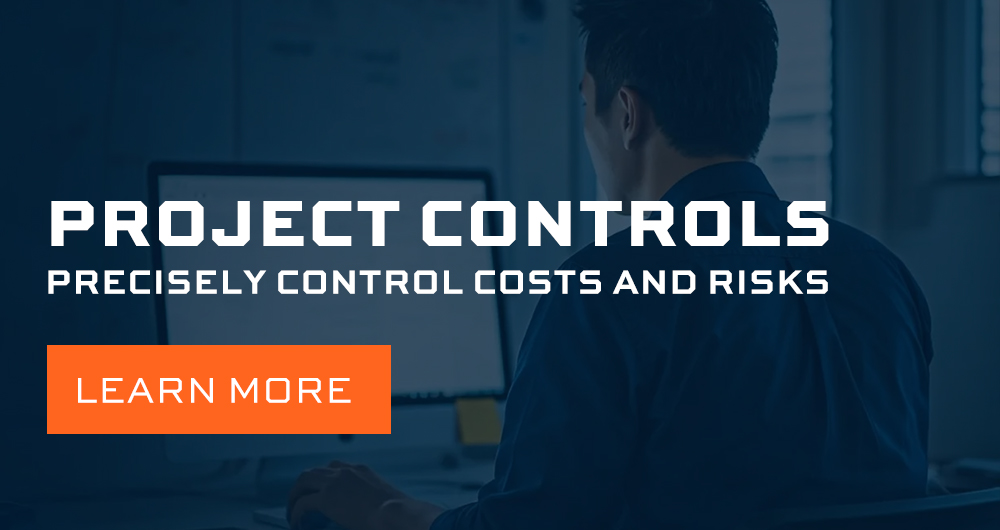Earned value management (EVM) is a common way to evaluate how well construction projects are doing in terms of performance and progress. It’s especially effective in helping monitor and manage projects that tend to be more complicated, involve longer build timelines and entail substantial budgets.
Within EVM are two metrics, schedule performance index (SPI) and cost performance index (CPI), that serve as highly reliable tools to track and report on project schedule and cost efficiency. Calculated using equations unique to the respective metric, each is expressed as a simple numeric value. These numeric values usually hover within what’s called an operating range, defined as the acceptable high-low boundaries of a project’s time and money efficiency. So, for SPI and CPI, their values are typically expected between 1 and -1, with 1 indicating things are either ahead of schedule or below budget and -1 signaling the project is running behind or over budget.
The importance of operating ranges for these two EVM metrics extends beyond just serving as the guardrails for assessing performance measures. Here are several essential ways it can be used throughout the project life cycle.
What an operating range enables you to do
Plan projects more effectively. If you have past project data, complete with SPI and CPI, it can serve as a guide for what to anticipate so you know how to realistically plan for future projects. Take a look at the risk events and situations that played out, and the degree to which cost and schedule were affected. Were the operating ranges sufficient at detecting the steeper fluctuations that warranted examination? If not, should those ranges be a bit narrower or wider for future similar projects that are likely to experience similar risks? Were contingency plans effective in preventing or mitigating any potential impact and bringing the metrics back within acceptable range? Answering these kinds of questions can either reaffirm the operating ranges or compel an adjustment that makes objective sense for the project.
Manage performance during construction. Once the build is underway, SPI and CPI will constantly shift within this range, responding in real time to the internal and external factors that affect the project. No matter what kinds of factors surface — whether they’re decisions, actions, events, or situations — the operating ranges on which their impact on project performance is evaluated remains the same. More specifically, it helps define what is normal and what is not, while ensuring projects are being tracked and managed properly without being overly lax or overly strict with expectations.
Know what’s worth devoting time to. This may not always be obvious and can escape detection when your project management efforts are focused elsewhere. SPI and CPI are useful tools for diagnosing problems on your project, but they don’t tell you what’s causing those problems or how you can fix them. Rather, these EVM performance metrics serve as a kind of built-in warning system, with their operating range defining when those metrics demand more scrutiny. Focusing energies on investigating causes of cost or schedule deviations gives you a better chance of avoiding, managing, or mitigating potential or actual risks, and therefore bringing the metrics back within acceptable range.
Achieve more project control and certainty. With so many tasks, data points and risk factors involved in capital projects, it can seem like there’s painfully little that can be adequately managed. Gaining project control and certainty depends on determining whether your project is on track or not. Both SPI and CPI provide real-time objective measures that help you monitor progress against planned activities and identify problems early enough to take corrective action — before they become major issues that lead to timeline or budget overruns. This is how these metrics take on a more predictive role, helping you proactively plan, decide and act in response to their ebb and flow with respect to their operating ranges.
Defining an operating range
Between 1 and -1 has been a standard range for most projects. But how far above or below these values is perhaps too much? In other words, is there a threshold that would be too high relative to 1? And what would be considered too low relative to -1 and cause for alarm? That depends on the project because no two projects are exactly alike, and neither are the risks they may face. What is regarded as a normal range for one project may not be normal for another.
Again, look to past project data as a reference point. SPI and CPI fluctuations can be analyzed to help tweak their respective operating ranges for future projects that may be affected by similar internal and external factors. But also go beyond the objective data by considering the subjective experiences and expertise of seasoned project team members — from project managers to veteran workers on the jobsite. If the project has been executed before with similar scope, they may have unique experiences and perspectives to share on how to respond to and manage different risk factors; this knowledge can be considered when further defining the operating ranges for SPI and CPI metrics.
Effectively and efficiently track and manage all this with EVM software
Monitoring project health and performance is a massive undertaking. Fortunately it’s made much simpler, more accurate and timelier with software technology that streamlines the EVM process, from the importing of historical data, to the ongoing SPI and CPI calculations, to regular reporting of project status.
Where this technology makes a difference within operating ranges is in its ability to set those ranges, monitor and recognize when either metric nudges past their set boundaries, and automatically push out alerts notifying the appropriate team members and/or stakeholders when they do. Digitizing EVM metrics and the operating ranges they hinge on maximizes time and effort in managing and tracking the overall efficiency and health of even the most complex capital and infrastructure assets.
One such robust option to consider is InEight Earned Value Management. Learn how to apply it to your projects by scheduling a consultation.




